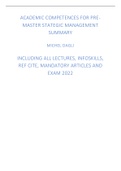1 INTRODUCTION AND OVERVIEW
1.1 DEFINITIONS OF LEADERSHIP
Most definitions of leadership reflect the assumption that it involves a process whereby intentional
influence is exerted over other people to guide, structure, and facilitate activities and relationships in
a group or organization.
1.1.1 Specialized Role or Shared Influence Process?
One view is that all groups have role specialization, and the leadership role has responsibilities and
functions that cannot be shared too widely without jeopardizing the effectiveness of the group. The
person with primary responsibility to perform the specialized leadership role is designated as the
“leader”. Other members ae called “followers” even though some of them may assist the primary
leader in carrying out leadership functions. The distinction between leader and follower role does not
mean that a person cannot perform both roles at the same time.
Another way to view leadership is in terms of an influence process that occurs naturally within
a social system and is diffused among members. According to this view, various leadership functions
may be carried out by different people who influence what the group does, how it is done, and the
way people in the group relate to each other. Leadership may be exhibited both by formally selected
leaders and by informal leaders. Important decisions about what to do and how to do it are made
through the use of an interactive process involving many different people who influence each other.
1.1.2 Type of Influence Process
Some theorist would limit the definitions of leadership to the exercise of influence resulting in
enthusiastic commitment by followers, as opposed to indifferent compliance or reluctant obedience,
and that manipulation, punishment and rewards is not really leading but rather controlling. Others
argue that this is too restrictive because it excludes some influence processes that are important for
understanding why a leader is effective or ineffective in a given situation.
1.1.3 Purpose of Influence Attempts
One viewpoint is that leadership occurs only when people are influenced to do what is ethical and
beneficial for the organization and themselves. An opposing view would include all attempts to
influence the attitudes and behavior of followers in an organizational context, regardless of the
intended purpose or actual beneficiary. The outcomes of leader actions usually include a mix of costs
and benefits. Also, something intended for the leader’s own cause can have positive effects on the
organization as well and thus research should not be limited to the leader’s intended purpose.
1.1.4 Influence Based on Reason or Emotions
As opposed to earlier research, recent conceptions of leadership emphasize the emotional aspect of
influence much more than reason. According to this view, only the emotional, value-based aspects of
leadership influence can account for the exceptional achievements of groups and organizations.
1.1.5 Direct and Indirect Leadership
A leader can directly influence his immediate subordinates, but a leader can also influence other
people inside the organization who do not report to the leader. Direct forms of leadership involve
attempts to influence followers when interacting with them or using communication media to send
messages to them. Indirect leadership has been used to describe how a chief executive can influence
people at lower levels in the organization who do not interact directly with the leader.











